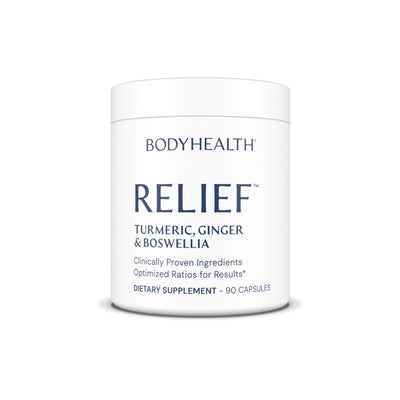What Are Autoimmune Conditions & How Do They Work
June 19, 2025 5 min read

Disclaimer: This article is purely informational and makes no claims as to treatment or cure from any supplement or program BodyHealth may offer. If you or someone you know has an autoimmune condition we recommend you see a doctor trained in functional medicine to help you locate the cause of the condition and recommend a solution for it.
This is the first article in the Autoimmune Series, where we cover what autoimmune conditions are, what is causing them, and what you can do about them.
It's also the first article in the Gut Health Series, which you'll find an index to at the bottom of this page.
We’ll first cover what they are broadly and then dive into specific conditions in later articles.
AUTOIMMUNE CONDITIONS ARE GROWING FAST
About 1 in 10 people in the US now suffer from some sort of autoimmune disease. And this level has been rising fast over the last couple of decades.
It’s rising fastest amongst adolescents, where the number has tripled in the last 3 decades.
In 1988-1991 an estimated 22 million people between 12 and 19 years old had an autoimmune disease, and in 2011-2012 it rose to 41 million.
But it affects adults as well, generally manifesting somewhere between the ages of 15-45. And about 75% of those affected are female.
These are conditions such as Lupus, Rheumatoid Arthritis, Crohn's disease, Fibromyalgia, Hashimoto’s, Ulcerative Colitis and a host of some 80 others.
And other conditions, such as Lyme disease, can trigger autoimmune conditions.
These can cause low thyroid, muscle pain or fatigue, stiff or painful joints, and exhaustion and lethargy. Or they can attack specific organs or nerve cells, and even the skin.
But what is an autoimmune condition? What's happening in the body when someone has one?
WHAT IS AN AUTOIMMUNE CONDITION
“Auto” means self and “immune” refers to the system in your body that is supposed to identify and attack… “not-self.”
It’s literally where our immune cells, which are supposed to fight off foreign invaders such as harmful bacteria or viruses, start identifying specific cells in our bodies as foreign invaders and so attack us.
This destroys cells and brings inflammation and in some cases can become quite severe.
For example, in an autoimmune condition, if your immune system starts seeing your nerve cells as foreign invaders, starts thinking they actually are foreign invaders, then it attacks them, and we get pain and inflammation.
Or if it starts seeing the cells of your thyroid as foreign invaders, then it attacks them, causing swelling, possibly cysts, and low thyroid hormone.
And it does this to “protect” you from them, not realizing they are you.
So how does this come about?
To answer this we need to first look at how the immune system operates so we can then see where it’s going wrong.
HOW THE IMMUNE SYSTEM LOCATES FOREIGN INVADERS
We know the immune system fights off foreign invaders. But it’s actually much simpler than that. What it’s really fighting off is “not you’s.”
It’s a “not you” detection system. It attacks things which are not you.
If a harmful bacteria comes, it’s not you and the immune system attacks.
If a toxic heavy metal or other chemical comes in, it’s not you and the immune system attacks.
This is also why people can have trouble with organ transplants or blood transfusions. The cells on these organs are not exactly the same as your own in specific ways, "not you," and so the immune system may attack them.
And this comes down to how the immune system determines what isn’t you.
And it has to do with proteins.
Each cell in your body has a protein marker on the surface of the cell which is your individual, unique ID tag.
All of your cells have this.
But if foreign bacteria, viruses or parasites come in, they don’t have this. They don’t have your specific ID tag.
This even happens with proteins you eat, animal or vegetable, which aren’t fully broken down.
If your digestive system isn’t functioning fully, and not all of the proteins you eat are fully broken down, your immune system can also see these partially broken down proteins as foreign invaders and attack them.
To your body, anything coming in through your digestive tract should either be individual amino acids (fully broken down proteins) or other foods that have been fully broken down.
Anything else shouldn’t be there.
It’s fully broken down foods, or cellular tissue that have your ID tags on the proteins, or it’s not you and gets attacked.
But this is when your immune system is functioning properly.
Let’s see what’s happening when it’s not…
HOW AUTOIMMUNE CONDITIONS ARE FORMED
So we know your immune system looks at the protein structures on the things coming into it.
In an autoimmune condition it’s seeing the protein tags on your own cells and thinking they are foreign invaders.
This can come from a few different things but, essentially, there has been some corruption of the ID tag on those cells.
And thats the key.
If you have heavy metals or foreign invaders that came in through food or water, and they’re now sitting on a cell surface, or if the surface proteins on your cells are damaged in some way by these heavy metals, toxins, plastic residues, or bacteria or viruses, this can either confuse the immune cells looking at them, or it can directly corrupt the protein tag itself so it’s different than what it’s supposed to be and so, no longer "you."
So the immune cell looking at a kidney cell or joint cell or thyroid cell "sees" a foreign invader and attacks.
Or, even more commonly, you can have bacteria where their own cell surface markers look very similar to ours and our immune cells can become confused and so attack.
These foreign invaders and toxins, coming in through our intestine and into the blood stream, can go most anywhere. And they lodge in joints or get into organs or muscle tissue.
This, along with the damage the bacteria and toxins do themselves, is what we call autoimmune disease.
The only differences are in the types of foreign invaders and where they land.
But it's all caused by these foreign invaders, toxins and heavy metals getting into our bodies.
Something which never should have happened.
And that we'll cover in the next article.
And we also have a full Gut Health Guide & Protocol you can see below.
And if you haven't already, make sure you join our PerfectAmino FaceBook Group, where you can ask all your health & fitness questions.
Index To The Gut Health Guide:
The Autoimmune Series:
- What Are Auto-Immune Conditions & How Do They Work
- Leaky Gut, Gut Health & Auto-Immune Conditions
- How To Address Autoimmune Conditions
The Gut Health Protocol:
- The Gut Health Guide & 30-Day Challenge
- The Gut Health Protocol
- Your Gut Health Schedule
- Running Your Gut Health Protocol
Digestion: Acid Reflux, Bloating, Muscle, Fat Loss & More:
- What Causes Sugar Cravings & A Protruding Stomach
- Why Proper Protein Digestion Is So Important
- What Causes Acid Reflux, Heartburn & GERD
- How Poor Gut Health Leads To Poor Heart Health
Leaky Gut: SIBO, Toxins, Glyphosate & Gluten:
- SIBO & Leaky Gut: A Root Cause Of Poor Health
- Glyphosate, Leaky Gut, The Microbiome & Physical Conditions
- How Leaky Gut Causes Premature Aging
- What Is Gluten Face & Wheat Belly
The Microbiome: Stress, Recovery, Mood & Overall Health:
- Depression, Anxiety, Stress & Sleeplessness — The Microbiome
- How Toxins Affect The Microbiome & Overall Health
What Is Candida & How Do We Address It?
How Gut Health Affects Skin Health:
Where To Go From Here:
Articles by Health Topic
Your Path To Better Health Starts Here!
From in-depth articles on nutritional benefits to updates on new product launches, stay informed and inspired on your journey to optimal health.
*These statements have not been evaluated by the Food and Drug Administration. These products are not intended to diagnose, treat, cure, or prevent any disease.











